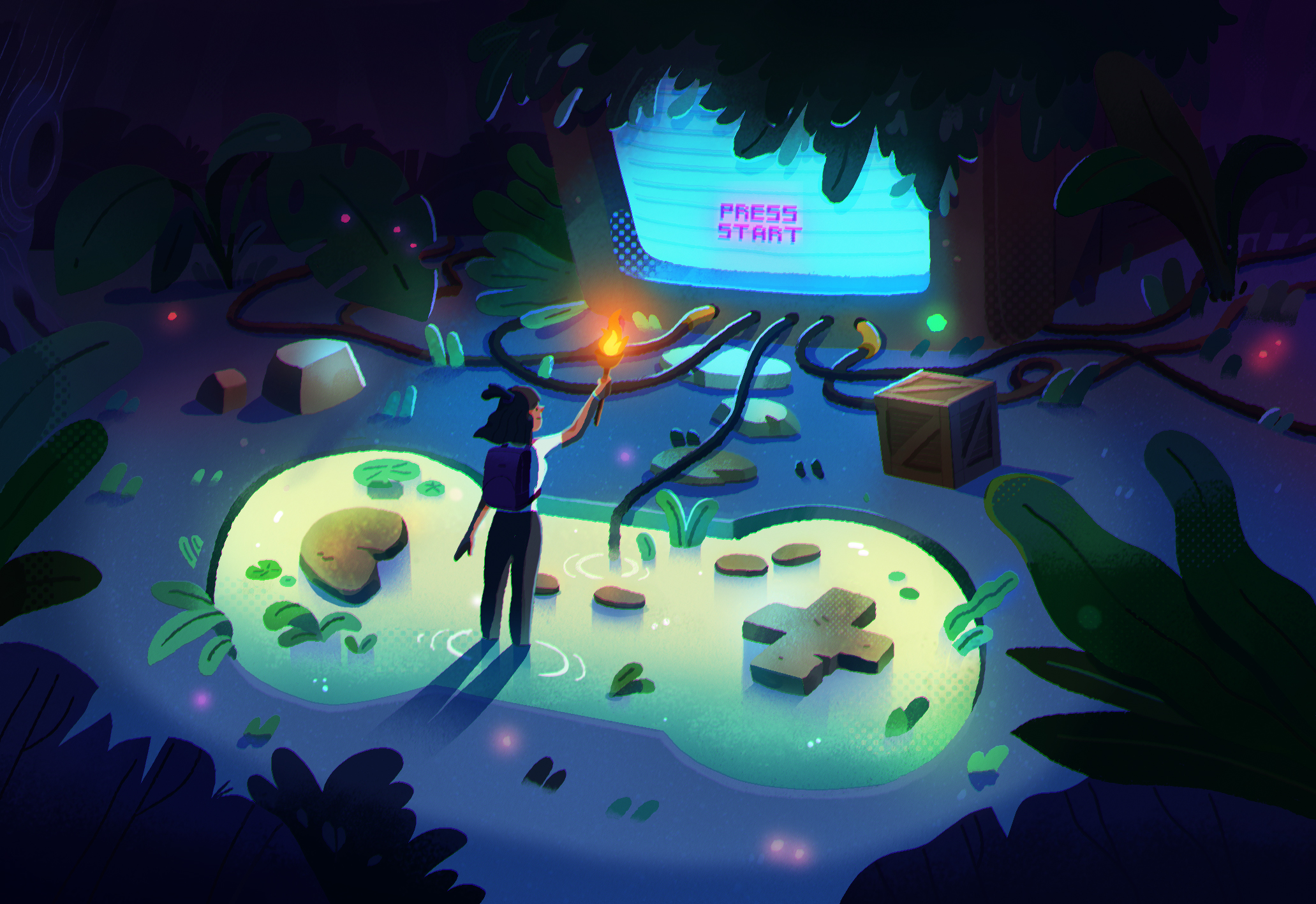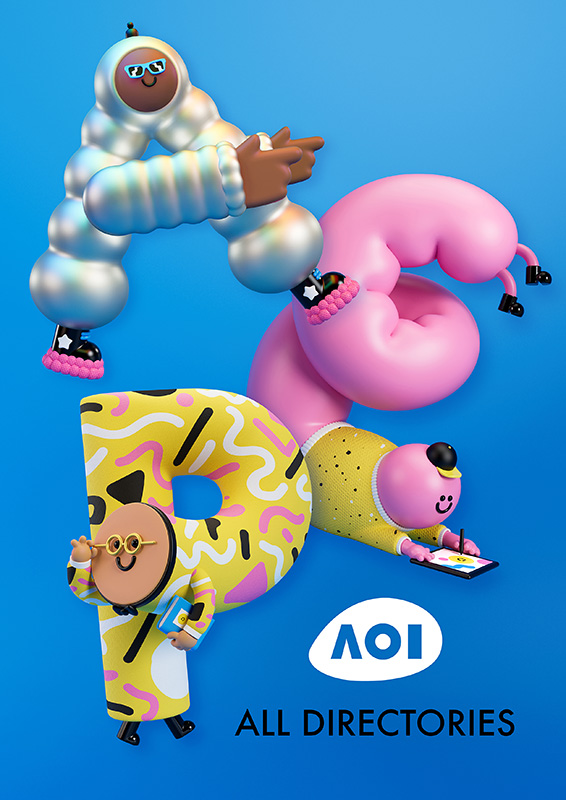All the basic information you need for creating work for gaming projects.
In this article
What are the basics you need to know about illustration for gaming? In the following resource we cover the different roles for illustrators, studio types, what you’ll need in your portfolio, along with working in teams.
This resource is an edited version of the full How To Get Into Illustration for Gaming publication by Anna Hollinrake, art director, illustrator, game developer, available exclusively to AOI members.
Illustration for Gaming
Working in games can be a weird, wonderful experience where you’re constantly reinventing the wheel, finding new ways to create characters and worlds whilst utilising cutting edge technology and working in teams whose skillsets vary widely. Making art for games involves problem solving on visual, thematic, and technical levels – and it’s incredibly satisfying when all three come together. Let’s talk about some illustration-adjacent roles!

Roles for Artists in Games
The most well known role is the Concept Artist, an artist who designs characters, environments, props, vehicles; anything that might be featured in-game that needs visual design and iteration. Their role can sometimes extend out to also cover marketing art or key art; marketing art existing to promote the game and often being much more polished than concept art, and key art being the main promotional image.
Whilst the majority of the art roles in games tend to be for 3D game asset production, a large number of games are still made in 2D, which is a great opportunity for illustrators looking to apply their skillset to games. The 2D Artist creates more polished, production-quality in-game assets like layered environment backdrops, pixel sprites, or character portraits. 2D games are often cheaper to make, with more opportunity for experimental art styles. Concept artists can often fill this role, also.
Another role that leans more closely to graphic design is the UI Artist, whose responsibility is creating graphics for the user interface: menus, buttons, maps, dialogue boxes
Studio Types and Contracts
Team sizes in games can vary wildly – from solo developers or indie studios of 1-20 people, to AA or AAA games, which can be in the hundreds. Contract types vary, with full time, permanent roles becoming less common, but contractor roles still being relatively long due to games taking a lot of time to make. A game can often take 1-3 years to make, with larger, high budget AAA games reaching 5 years or more.
Many freelance contractor roles (both in indie and AAA) work on day rates as it is hard to estimate how much work will be required for a large number of tasks after feedback and implementation, with day rates significantly varying depending on experience level, subject matter and technical expertise. Senior roles will be better compensated than junior or indie roles.
Working In Teams
Art is almost always created digitally, most commonly using Photoshop. Whilst the games industry requires a lot of technical know-how, artists don’t always need to be familiar with things like 3D software or game engines. It depends on how much the artist will be putting their work (or ‘implementing’) into the game build itself; a UI Artist will likely be doing a lot more implementation than a concept artist.
When starting a new piece of concept work for games, the game designer will usually have an idea of how a level should look and feel, or the writer will have an idea of the character. This will usually still be briefed by the Art Director.
When it comes to project organisation, tools like Trello that use kanban boards are common. Software like Notion or Jira that allow for task-time estimates and long-term planning are used frequently, and work is often divided up into two week long ‘sprints’, often with an overarching goal per sprint for a team to achieve
Building Your Portfolio
As always, a well put together, effective portfolio is required. It can be helpful for clarity when applying to games roles to make a separate portfolio exclusively for games, even if it has a lot of work crossover.
When putting together a portfolio for a game role from an illustration perspective, it’s important to think about functional design and how the work builds toward a larger project first and foremost. Concept art should always be solving problems down the pipeline – creating a prop concept with geometry that isn’t physically possible will make life hard for the 3D artist who has to model it.
Character concept art for 3D will usually require turnarounds (the front, back, and side view of the character) with extra sketches for detailed props, and material callouts (swatches of materials like silk or leather) to give the 3D artist more information on how to create different parts of the outfit.
Environment concept art can vary from ‘look and feel’ concepts, to 3/4 view breakdowns of levels, depending on where the project is in production. Once again, the space needs to make sense as it will likely need to be translated to 3D or final 2D production art, so thinking about how a character will traverse the space is vital!Portfolio composition can differ from illustration as appealing imagery is less important than visual problem solving. It’s incredibly valuable to have multiple images from one project rather than many disparate pieces
In conclusion, making the jump from illustration to video games, whilst maybe daunting, offers a massive range of opportunities for artists with strong visual communication skills and a delighted curiosity for game development.
AOI Members can explore the area of site specific Illustration in more depth in the How To Get Into Illustration for Gaming publication written by illustrator and game creator Anna Hollinrake.
Go here to read the Fashion Illustration Basics
Go here to read the Publishing Season: Book Covers Basics
Go here to read the Site Specific Illustration Basics
Go here to read the Illustration for Children Basics
Go here to read the Branding Illustration Basics
Go here to read the Editorial Illustration Basics
AOI Members have access to all Inside Illustration content.
Members also have access to the AOI’s Pricing Calculator, which assists with quotes for a range of areas of illustration commissioning.
To help find clients, AOI produces regularly updated Client Directories at a reasonable price, with contacts for advertising and design, publishing and editorial companies.
AOI speaks directly to the commissioners and passes on information about the kind of work they’re looking for. Details include names, role, email addresses, address, socials and more.
The AOI would like to make resources accessible to all members. If you would like an alternative format please ask.

